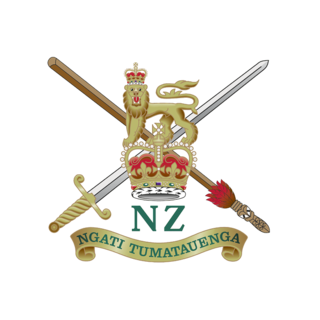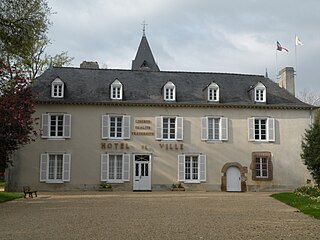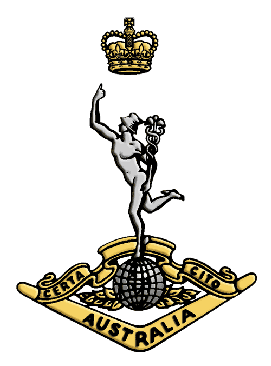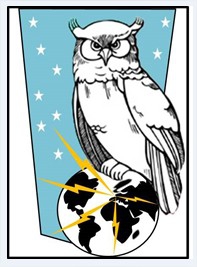
The Royal Corps of Signals is one of the combat support arms of the British Army. Signals units are among the first into action, providing the battlefield communications and information systems essential to all operations. Royal Signals units provide the full telecommunications infrastructure for the Army wherever they operate in the world. The Corps has its own engineers, logistics experts and systems operators to run radio and area networks in the field. It is responsible for installing, maintaining and operating all types of telecommunications equipment and information systems, providing command support to commanders and their headquarters, and conducting electronic warfare against enemy communications.

The French Air and Space Force (AAE) is the air and space force of the French Armed Forces. Formed in 1909 as the Service Aéronautique, a service arm of the French Army, it became an independent military branch in 1934 as the French Air Force. On 10 September 2020, it assumed its current name, the French Air and Space Force, to reflect an "evolution of its mission" into the area of outer space.

The Royal New Zealand Signals Corps (RNZSigs) provides, co-ordinates and operates the communications networks of the New Zealand Army. The role of RNZSigs is to support other Arms by providing Communication Information System required for Command and Control of Units, Formations and Administrative installations in a theater of Operations and in the New Zealand support area. Modern signal equipment is essential to the army, demanding skilled operators and technicians. Because communications must be maintained even under the worst of conditions, signallers must be expert tradespeople. They must also accept a high degree of personal responsibility because the lives of soldiers can often rely on the fast and accurate transmission of battlefield information.

Cesson-Sévigné is a commune in the Ille-et-Vilaine department in Brittany in northwestern France.
The Royal Canadian Corps of Signals is a component within the Canadian Armed Forces' Communications and Electronics Branch, consisting of all members of that personnel branch who wear army uniform. Prior to 1968 it was a combat support corps of the Canadian Army. The Royal Canadian Corps of Signals was re-instituted in 2013. It provides communication support and information systems for the Canadian Army.

The Royal Australian Corps of Signals (RASigs) is one of the 'arms' of the Australian Army. It is responsible for installing, maintaining, and operating all types of telecommunications equipment and information systems. The motto of the Signals Corps is Certa Cito and is translated as 'Swift and Sure', signifying the aim of the signal service – that communication be carried out with maximum speed and certainty. Like their British counterparts, the Royal Australian Corps of Signals' flag and hat badge feature Mercury, the winged messenger of the gods, affectionately referred to by members of the corps as "Jimmy".

The Communications and Electronics Branch is a personnel branch of the Canadian Armed Forces (CAF). The army component of the branch is designated the Royal Canadian Corps of Signals.
The structure of the French Army is fixed by Chapter 2 of Title II of Book II of the Third Part of the Code of Defense, notably resulting in the codification of Decree 2000-559 of 21 June 2000.

The Sri Lanka Signals Corps (SLSC) is a combat support corps of the Sri Lanka Army, responsible for providing military communications, information technology and electronic warfare support. The corps is made up of a signals brigade, ten regular regiments and one volunteer regiment. It is responsible for installing, maintaining and operating all types of telecommunications equipment and information systems. It is headquartered at the Panagoda Cantonment.

The National Defence Medal is a French military decoration. It was created by Charles Hernu, Minister of Defence and established by decree on 21 April 1982. It rewards particularly honourable service rendered by military personnel for their participation in operational activities. The medal has three levels: Gold, Silver and Bronze.

The Fort de Bicêtre is a military structure built between 1841 and 1845 during the reign of Louis-Philippe during a time of tension between France and England, in the Paris suburb of Kremlin-Bicêtre. The fort is part of the Thiers Wall fortifications of Paris, built under a program of defensive works initiated by Adolphe Thiers. The fort served as a prison for those involved in the French coup of 1851.

The 14th Signal Regiment (Electronic Warfare) is a part of the British Army's Royal Corps of Signals. The regiment's role is to provide electronic warfare (EW) capability in support of deployed Land Commanders, in order to enable operations in the electronic battlespace. It is the only British Army regiment capable of conducting sustainable electronic warfare in support of national operations worldwide. The regiment is currently based at Cawdor Barracks, on the site of the former RAF Brawdy, near Haverfordwest, in South Wales.

The Czech Land Forces are the land warfare forces of the Czech Republic. The Land Forces consisting of various types of arms and services complemented by air and special operations forces constitute the core of the Czech Armed Forces. Land Forces Command is located in Olomouc.
The following is a hierarchical outline for the Canadian Armed Forces at the end of the Cold War. It is intended to convey the connections and relationships between units and formations.

39 Signal Regiment, formerly known as 744 Signal Regiment in Vancouver, 741 Signal Squadron in Esquimalt and 748 Signal Squadron in Nanaimo, is a Primary Reserve Canadian Army unit of the Royal Canadian Corps of Signals in Vancouver, Victoria and Nanaimo, British Columbia.

The Intelligence Command is a military intelligence formation of the French Army formed following the end of the Cold War and expanded after the 2016 reorganisations.
Future Soldier is a reform of the British Army resulting from the Integrated Review of Security, Defence, Development and Foreign Policy published in March 2021. The aim of the reform is to create a more lethal, agile and expeditionary force, able to fight and win wars and to operate in the grey-zone between peace and war. Future Soldier was published on 25 November 2021 and deals with the organizational changes of the British Army, with changes to personnel and equipment were set out in the Defence in a Competitive Age paper published on 22 March 2021.

The United States Army NATO Brigade (USANATO) is a US Army brigade providing training, logistics, human resources, and service-specific support at 81 US Army NATO locations across 21 countries. The brigade headquarters is based in Sembach in Germany.













